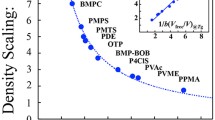Abstract
A model for non-Arrhenius structural and dielectric relaxation in glass-forming materials is based on defect clustering in supercooled liquids. Relaxation in the cold liquid is highly hindered, and assumed to require the presence of a mobile defect to loosen the structure near it. A mild distribution of free-energy barriers impeding defect hopping can generate a wide distribution of waiting times between relaxation events. When the mean waiting time is longer than the time of an experiment, no characteristic time scale exists. This case directly yields the Kohlrausch-Williams-Watts (KWW) relaxation law. A free-energy mismatch between defect and nondefect regions produces a defect-defect attraction, which can lead to aggregation. This may occur in defect-rich “fragile” liquids which also exhibit Vogel kinetics. Defect aggregation and correlation in the “high-temperature” region above the critical consolute temperatureT c is described using the Ornstein-Zernike theory of critical fluctuations. For a defect correlation length divergence (T-T c)-γ/2, a generalized Vogel law for the structural relaxation time τ results: τ=τ0exp[B./(T-T c)1.5γ] In the mean-field limit (γ=1) this provides as good an account of dielectric and structural relaxation in glycerol,n-propanol, andi-butyl bromide as does the original Vogel law, and for the mixed salt KNO3−Ca(NO3)2 and B2O2 it also describes kinetics over their entire temperature ranges. A breakdown of the Vogel law in the immediate vicinity ofT g is avoided, and the need to invoke extra low-temperature mechanisms to explain an apparent “return to Arrhenius behavior” is removed.
Similar content being viewed by others
References
A. V. Tobolsky,Properties and Structure of Polymers (Wiley, New York, 1960), Chapter II.
P. W. Anderson, inIll-Condensed Matter, R. Balian, R. Maynard, and G. Toulouse, eds. (North-Holland, New York, 1979), p. 162.
G. Williams and D. C. Watts,Trans. Faraday Soc. 66:80 (1970).
E. W. Montroll and J. T. Bendler,J. Stat. Phys. 34:129 (1984).
M. F. Shlesinger and E. W. Montroll,Proc. Natl. Acad. Sci. USA 81:1280 (1984).
J. Klafter and M. F. Shlesinger,Proc. Natl. Acad. Sci. USA 83:848 (1986).
J. T. Bendler and M. F. Shlesinger,Macromolecules 18:591 (1985).
S. H. Glarum,J. Chem. Phys. 33:1371 (1960).
P. Bordewijk,Chem. Phys. Lett. 32:592 (1975).
J. T. Bendler and M. F. Shlesinger,J. Mol. Liquids 36:37 (1987).
R. Kohlrausch,Pogg. Ann. Physik 91:198 (1854).
F. Kohlrausch,Pogg. Ann. Physik 119:352 (1863).
F. T. Pierce,J. Text. Inst. 14:T390 (1923).
C. R. Kurkjian,Phys. Chem. Glasses vol.4:128 (1963).
J. de Bast and P. Guard,Phys. Chem. Glasses 4:117 (1963).
A. A. Jones, J. F. Ogara, P. T. Inglefield, J. T. Bendler, A. F. Yee, and K. L. Ngai,Macromolecules 16:658 (1983).
R. V. Chamberlin, G. Mozurkewich, and R. Orbach,Phys. Rev. Lett. 52:867 (1984).
U. Even, K. Rademmann, J. Jortner, N. Manor, and R. Reisfeld,Phys. Rev. Lett. 52:2164 (1984).
G. D. Patterson,Adv. Polymer Science 48:125 (1983).
J. T. Bendler, D. G. LeGrand, and W. V. Olszewski,Polymer Preprints (ACS) 26(2):90 (1985).
L. D. Landau and E. M. Lifshitz,Statistical Physics (Pergamon Press, London, 1958), Sections 109–115.
M. E. Fisher,J. Math. Phys. 5:944 (1964).
D. W. Davidson and R. H. Cole,J. Chem. Phys. 19:1484 (1951).
D. J. Denney,J. Chem. Phys. 30:159 (1959).
R. Weiler, S. Blaser, and P. B. Macedo,J. Phys. Chem. 73:4147 (1969).
P. B. Macedo and A. Napolitano,J. Chem. Phys. 49:1887 (1968).
S. W. Martin and C. A. Angell,J. Phys. Chem. 90:6737 (1986).
W. Kauzmann,Chem. Rev. 43:219 (1948).
Author information
Authors and Affiliations
Additional information
This paper is dedicated to Prof. N. G. van Kampen on the occasion of his 67th birthday.
Rights and permissions
About this article
Cite this article
Bendler, J.T., Shlesinger, M.F. Generalized Vogel law for glass-forming liquids. J Stat Phys 53, 531–541 (1988). https://doi.org/10.1007/BF01011571
Received:
Issue Date:
DOI: https://doi.org/10.1007/BF01011571




